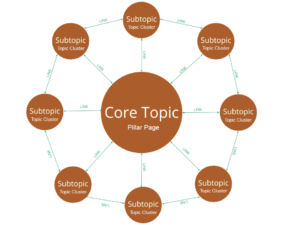
Law Firm SEO: Topic Clusters and Pillar Pages

Law firm marketers are essentially at the mercy of Google’s algorithm, which continues to evolve and become more complex and sophisticated. Nowadays, law firm websites that receive a large amount of traffic from search engines are those sites that follow Google’s preferred site architecture, organized using pillar pages and topic clusters. In this post, we’ll cover exactly what pillar pages and topic clusters are and how you can leverage them to increase website traffic and search engine visibility.
What is a pillar page?
HubSpot defines a pillar page as “a comprehensive resource page that covers a topic in depth and links to high-quality content for supporting subtopic keywords.” A pillar page creates a path for visitors to explore a topic in more depth as it hyperlinks to more detailed pages. These pages that link back to the pillar page help to establish a relationship between the resources.
What is a topic cluster?
Topic clusters, also sometimes called content clusters, are sub-topic pages that directly relate to your pillar content. “Cluster content” is basically just content that focuses on narrow topics related to the pillar page’s content. They cover keywords related to a pillar page in-depth and are linked internally to the corresponding pillar page.
How pillar pages and topic clusters work
The pillar and cluster content model is essentially a way for you to organize your website’s keywords by first focusing on your site’s overall topic. Topic clusters allow you to develop more content around certain keywords, which provides more opportunity to be found via the ways that people actually search for information online.
A good way to think about pillar pages and topic clusters is to envision a book; the pillar page is the book itself and topic clusters are the chapters. By framing your content around a clearly defined topic or subtopic, search engines can more easily understand what your page is about.
The structure turns out looking like this:
Example of a pillar and cluster content model
If you practice family law, you might have a pillar page dedicated to divorce. Pages you might include in the associated topic clusters are: child custody, alimony, equitable distribution, etc. Each of these pages will link back to the pillar page. The interlinking structure helps to improve visibility in search results and to establish topical authority for divorce law.
Takeaway
The pillar and cluster page methodology is an effective way to organize your law firm website content. The more content information you have on a pillar and its subtopics, the more internal links you’ll be able to create on your site, which helps improve UX, navigation and adds a significant boost to your law firm’s SEO. All pages should also apply on-page SEO best practices.
If you have questions on SEO, we detail everything lawyers need to know about developing an impactful SEO strategy in our SEO for Law Firm Websites eBook: click here to download our eBook.
If you need assistance developing a comprehensive SEO strategy that will improve your search visibility and increase the number of visitors to your firm’s website, contact us today.
Are you ready to get started generating new, qualified leads?
Contact us to get started and let us help you energize your digital marketing and business development efforts.
Contact Us


